Wine is produced in most US states and across many parts of California, but one area area stands out for the quality of its wines, the inland valleys of Napa, Russian River and Sonoma north of San Francisco. The first Californian vineyard was planted in 1769 by Father Junipero Serra at Mission San Diego de Alcalá but the father of the Californian wine industry is considered to be Hungarian soldier and merchant Count Agoston Harazsthy who in the mid 19th century made several trips to import cuttings from 165 of the greatest European vineyards. Harazsthy founded the Buena Vista winery and promoted planting of vines over much of Northern California. Prohibition between 1920 and 1933 left the wine industry in tatters and it was not until the 1980s that it fully recovered but now California is the source of some really world class wines.
Chateau St. Jean winery, Sonoma County
The final winery is a relatively modern one. Chateau St. Jean was founded only in 1973 but the French-style chateau buildings are older, built in 1920 as a summer home for Ernest and Maude Goff. The inevitable wine tasting and tours are available.
Wine Country
Napa Valley near Oakville
Surrounded by soft rolling hills, the Napa Valley has a Mediterranean climate that is ideal for growing wine grapes. The first commercial winery in the valley was established in 1861 by Charles Krug at St. Helena and by the end of the 19th century there were more than 140 wineries operating in the area.
City Hall, Sonoma
The city of Sonoma stands at the heart of the valley. The town of El Pueblo de Sonoma began with the founding of Mission San Francisco Solano in 1823 by Father Joseph Altimira of Spain, the most northerly of the 21 Californian Missions. Laid out in the Mexican style around a large central Plaza, in 1846 Sonoma was for 25 days the capital of the independent California Republic, a brief reign that ended when California was annexed by the USA. Completed in 1908, Sonoma's City Hall is in the centre of the Plaza and is still used as offices by city administrators.
First Presbyterian Church, Napa
Although the Napa Valley was settled from the 1830s, it was not until 1848 that planning began for the town of Napa City. Agriculture in the valley, then based more on cattle ranching and timber than wine, ensured that Napa grew fast. The congregation of the First Presbyterian Church of Napa dates back to 1853 and the current church was completed in 1874. Modern day Napa is a centre for Napa Valley tourism, its restored buildings housing restaurants, tourist shops and art galleries. It is also the starting point for the Napa Valley Wine Train a diesel-hauled excursion along the tracks of the 1847 Napa Valley Railroad to St Helena. Food and wine are served and some excursions include winery tours.
Click on Minimap to navigate
Home > US States > The West > California >
Buena Vista Winery, Sonoma
So this is where the wine industry started in this area. Back in 1857 the Buena Vista Winery was set up Count Agoston Haraszthy, the father of the Californian wine industry. He established the vineyards and had lime stone tunnels dug into the hillside to provide cellars. The winery still operates today although the original cellars were destroyed in the 1906 San Francisco earthquake. It specialises in producing Pinot Noir, Chardonnay, Merlot and Cabernet Sauvignon. Like most California wineries, Buena Vista offers winery tours and for a fee you can taste the wines in their historic tasting room.
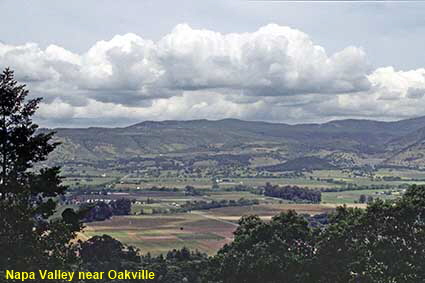
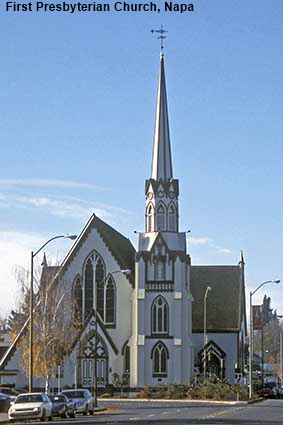
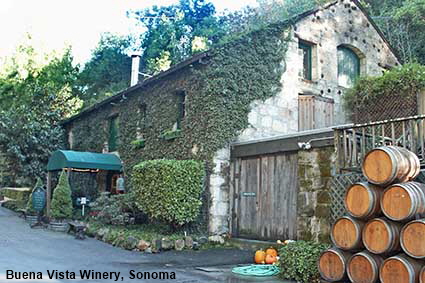
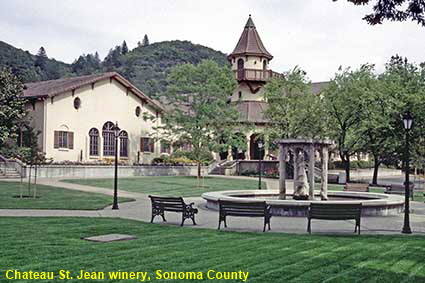

Greystone Winery, St Helena
The cars parked in front of the winery show that this is an old photograph. Brother Timothy, a member of the Catholic order Christian Brothers, played a major part in the recovery from Prohibition and creation of the modern wine industry. In 1935 he started commercial production in the valley and established Christian Brothers as a leading brand of Californian wine. Their base was the Greystone Winery a magnificent 19th century stone building originally built for a a wine co-operative. When we visited in 1981 we found the white wines good but the reds still fell short of European standards. In 1989 the winery was bought by a subsidiary of Britain’s Grand Metropolitan and in 1991 they sold the building to the Culinary Institute of America.
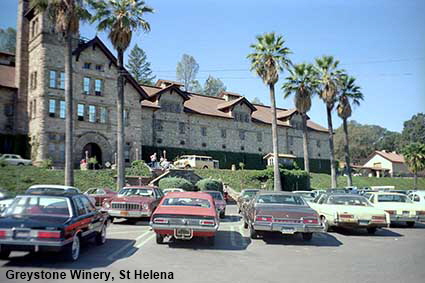
Water wheel in operation, Bale Grist Mill, St Helena
And finally something that is nothing to do with wine. In 1846 California was still (just) part of Mexico so it was the Mexican Government that gave Dr. Edward Turner Bale a land grant near to modern-day St Helena. On the land he built a water powered grist mill which continued in operation until the early 20th century. The mill has been partially restored and is protected as Bale Grist Mill State Historic Park. The huge water wheel is once again operational and at weekends it is used to power milling demonstrations.Click Tab 2 to see the grinding taking place inside the mill.



To move forwards or backwards through the California trail click the arrows above, or select your next destination on the Minimap.
DLU100604


© Mike Elsden 1981 - 2025
The contents of this page may not be reproduced in full or in part without permission